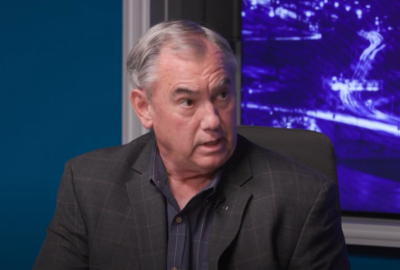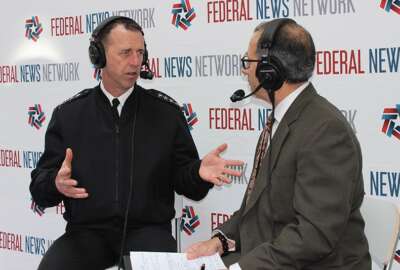Federal agencies and academics have a new way to test unmanned sea systems
The MITRE Corporation is celebrating the opening of what it says will help numerous federal agencies do a better job of studying national security, climate and...
The MITRE Corporation is celebrating the opening of what it says will help numerous federal agencies do a better job of studying national security, climate and environmental issues. The new BlueTech Lab in Bedford, Massachusetts opened its doors to federal agency sponsors last month. It includes a 620,000-gallon tank for testing unmanned surface and undersea systems – the biggest in the region. For more on what the federally-funded R&D corporation hopes to do with it, Federal News Network Deputy Editor Jared Serbu spoke with Nick Rotker, MITRE’s Chief Strategist for BlueTech on the Federal Drive with Tom Temin.
Interview Transcript:
Nick Rotker Absolutely, Jared. So over the past decade or so, we’ve been building out our capabilities internally. And the demand we are seeing from our sponsors right now is pretty unprecedented. We have folks reaching out to us across all of our different federal sponsors from Navy interests, NOAA, the National Oceanographic Atmospheric Agency, as well as U.S. Coast Guard and other sponsors that are interested in the maritime environment.
Jared Serbu So tell us about the facility itself. What’s it look like? And give us some sense of the scale. What can you do there?
Nick Rotker Yes. So the lab is one of MITRE’s largest investments that we’ve made over the past decades. And it’s one of the largest in the region. So it’s 106ft long by 40ft wide by 20ft deep. And it really allows for folks to come in and collaborate. So we’ve built this facility that has access to the outside community in a way that other MITRE Labs don’t typically foster. And so this lab is open right now, we’re looking for folks that are interested in utilizing this facility and partnering and collaborating with us to solve these problems in the maritime space.
Jared Serbu So it sounds like you don’t have any projects lined up quite yet, but give us a sense of the types of work that you would be able to do there.
Nick Rotker Absolutely. So given its size, we view it as ripe for the utilization of developing capabilities for autonomous platforms. So you want to be able to take your autonomous platforms, test them fully before you put them in the ocean, and inevitably things may go wrong and you may lose that platform. So a lot of the interest that we’ve had to date is really around underwater autonomous platforms, underwater sensing systems, capabilities where you’re communicating between platforms in the marine environment and things of that nature.
Jared Serbu And why is it important to have a lab set up this way? I mean, what can you do there that you couldn’t do in, let’s say, a protected cove? Is it about instrumentation? What are the big differences? And in that protected setting.
Nick Rotker Yeah. So in the controlled environment, you have a lot more ability to know what’s going on with both your platform and the environment. So it enables you to do much finer measurements. One of the capabilities of the lab is to be very precise beam patterns and measurement patterns of underwater transducers and hydrophones. The other capability that’s going to be unique to our facility is the underwater camera system that we have. So it is going to be one of the largest installations in the country of the Qualisys underwater camera system. And that allows 4.1cm accuracy anywhere within the tank. And so you can take an object, put it in the tank and enable real truth information of that platform. So if you’re developing autonomy, algorithms or other capabilities that need precise geolocation of your object undersea, this tank will allow you to measure all those so that you work out all the kinks before you put it in the ocean.
Jared Serbu And what’s kind of the range of agencies or MITRE sponsors who might be able to take advantage of something like this?
Nick Rotker So currently we have a lot of demand coming from both NOAA and our partners there, being able to test maritime platforms as well as a lot of our work from the U.S. Navy. So we do a lot of development of various sensing platforms, communication platforms. And so being able to test it in our own facility. We’re seeing a lot of demand from our sponsors in that place.
Jared Serbu What are the other components of the lab? I mean, is the tank really the star or what else do you have installed there?
Nick Rotker So besides just the tank, obviously it’s a very large controlled body of water, but we also have lab space for those who come in and utilize the facility, as well as the facility itself is actually the center of our blue nerve network. The Blue Nerve network is a capability that we’ve been working on in developing and rolling out across the country, and it allows us to actually connect geographically distributed labs and testing infrastructure across the country. And so our facility is going to be the hub of that network, and it’s going to allow us to collaborate with various maritime research institutions and government agencies across the nation.
Jared Serbu The news release that you guys put out in announcing this talked about it being possibly used for climate research, which is super interesting to me. How do you study something on the scale of the climate in a facility that’s relatively small compared to the Earth?
Nick Rotker So one of the things that the Blue Nerve Network is trying to do is connect all these institutions and reduce the barrier of entry for organizations to get access to maritime data. One of the main issues with trying to understand climate is that we don’t have enough data or access to data around the oceans. And so one of the things that the network is is attempting to do is connect all these various research institutions, government agencies, industry partners together so that we can start sharing all of this data that we’ve already paid for, we’ve already collected, already exists, and enable the community to access it in ways that they’re not able to at the moment.
Jared Serbu And is there like a particular government sponsor for the network or is MITRE just running this organically?
Nick Rotker So the original capability was developed about a decade ago for our intelligence community sponsors. So it’s a secure, unclassified network. It does require US only personnel to play on this network. However, the current instance of this Blue Nerve initiative, we have a grant from the state of Massachusetts in the Mass Tech Collaborative to run nine nodes across the state of Massachusetts. And so that’s connecting folks like Woods Hole Oceanographic Institute, Tufts University, Northeastern Massachusetts Maritime, UMass Boston, UMass Dartmouth and a couple others within the Massachusetts region. We also are connecting with partners across Rhode Island down at the Naval Undersea Warfare Center in Newport as a government collaborator, as well as the University of Rhode Island, and are looking to expand to other regions, including the West Coast and other partners across the country.
Copyright © 2025 Federal News Network. All rights reserved. This website is not intended for users located within the European Economic Area.
Jared Serbu is deputy editor of Federal News Network and reports on the Defense Department’s contracting, legislative, workforce and IT issues.
Follow @jserbuWFED







